paea
now browsing by tag
Balancing the Teacher and Artist in Me, By Jackie Thomas
Balancing the Teacher and Artist in Me
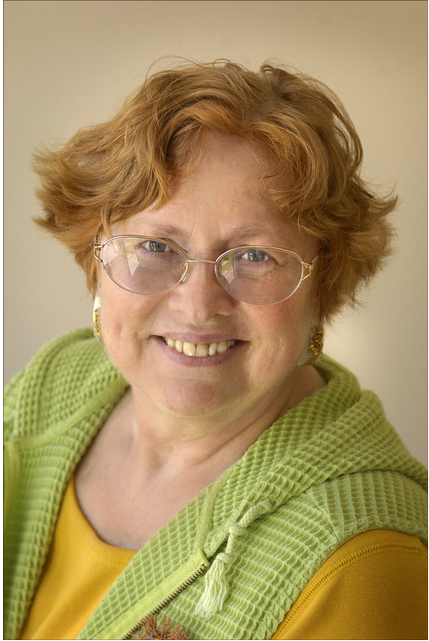
As a Fibers Artist, time has always been a challenge for me. Just plain living takes so much time, and when a teaching career is added, there is little left for the creative process and studio work. I thought I was not really productive in the studio while I was going through challenges of balancing home and school. But in retrospect, I realize I really was productive by channeling my creative energies in a number of ways:
As a brand new teacher, fresh out of college, and having already decided to specialize in Fibers. I packed up a project bag with a pre-woven rya rug backing (on which I drew a simple design), some yarns, a measuring tool, and a large tapestry needle. I kept the bag at school, available for the snippets of time available to work on the rya rug during faculty meetings and in the faculty room (I was told that teachers thought I was stuck up if I never left my classroom, so I scheduled a couple of periods a week to talk with teachers in the faculty room and did my planning at 5:30 in the morning and at home). It was a bulky bag that I lugged around, but I learned about trying to fit into the building and being a member of the larger school community. I believe it took all year to finish that Rya Rug.
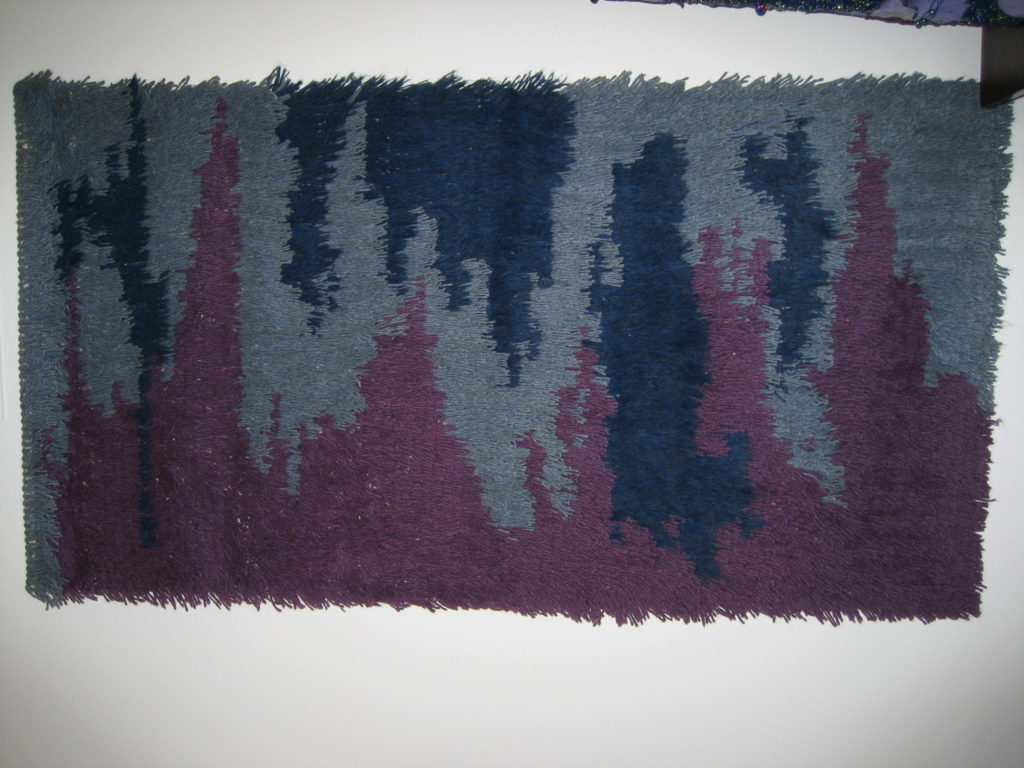
Time to balance teaching and art making didn’t shift any over the years, and I decided that I wanted to complete more than just one artifact in a school year. I looked for projects that would not require much of an investment in time. I tried jewelry making for a couple of years. A new bag of materials accompanied me to meetings and on car trips when someone else was driving.
Feltmaking jewelry:
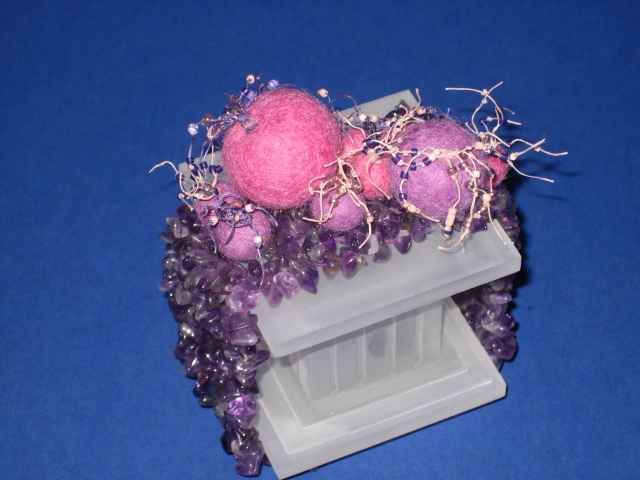
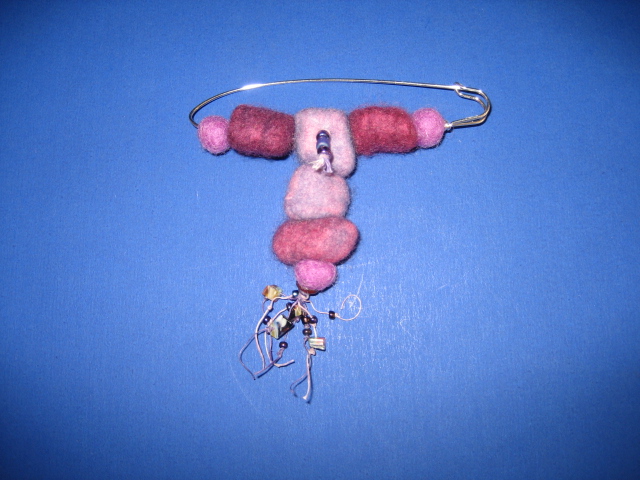
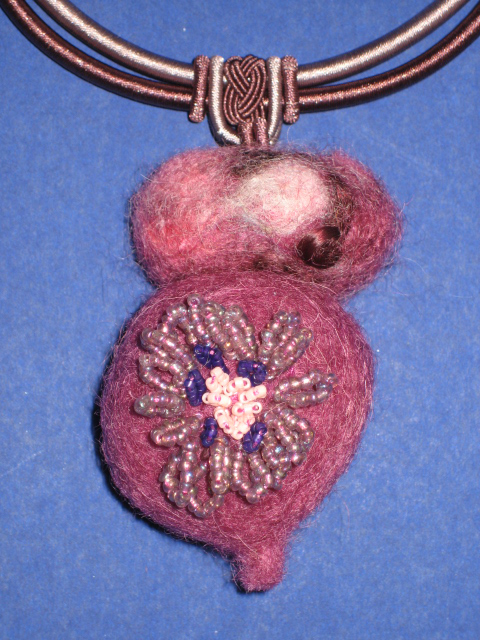
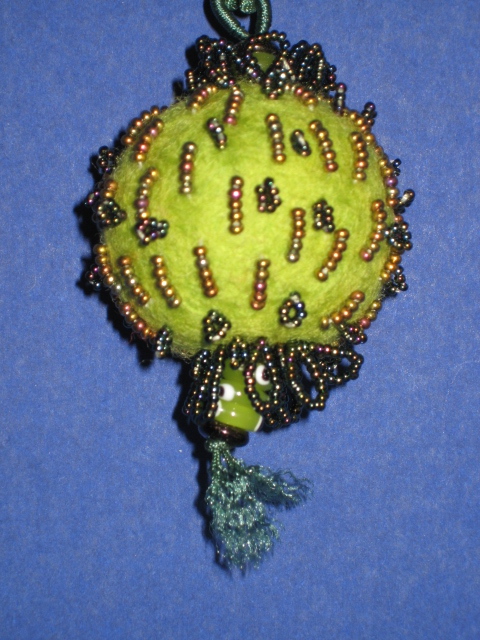

Waxed linen coiling/twining jewelry:
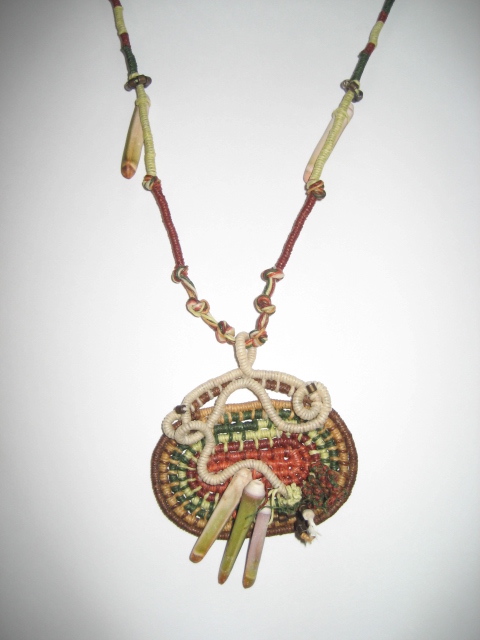
But I eventually decided I didn’t really find jewelry satisfying – too much assembly. And, fibers jewelry making was not really transferable and informative to teaching my students.
Quite by accident I began to make miniature dolls as fetishes and found that quite satisfying for more than ten years. My sister and I attended the American Crafts Council Baltimore Winter Market every year, and I bought one tiny wearable fetish animal doll from An African doll maker each year.
African Animal Fetishes:
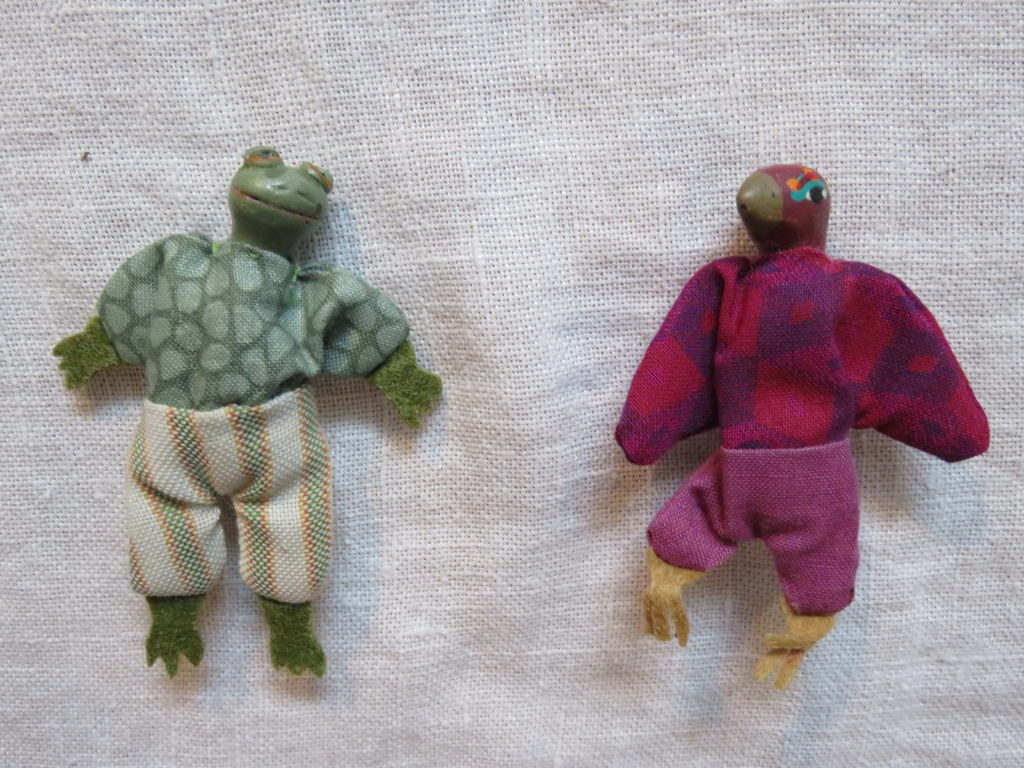
“A fetish is an object of magical powers. It is a guardian chosen by you. Once you have chosen your fetish you must promise to faithfully care for it. You must keep it in a warm, dry place and feed it one grain of corn or rice or bean each year. In return, it will insure you good health, clear sight, protection against injury, success in hunting and trading, and abundant love.”
After the fetish artist moved back to Africa, I went through fetish withdrawal, and I began to design and make my own little fetish dolls. I have worn a fetish every day over the past 40+ years.
I usually worked on a series of fetishes of one color/fabric but each with it’s own look/design (one to keep and the others to share). I tried to complete one step in each sitting (i.e. trace the pattern onto the cloth and cut them out; sew the fetish shape with right sides of the cloth together & leaving an opening along one leg; turn the cloth fetishes right side out, stuff them and stitching them closed; embroider the faces; add hair; clothe one fetish at a time).
Some of my Fetishes:
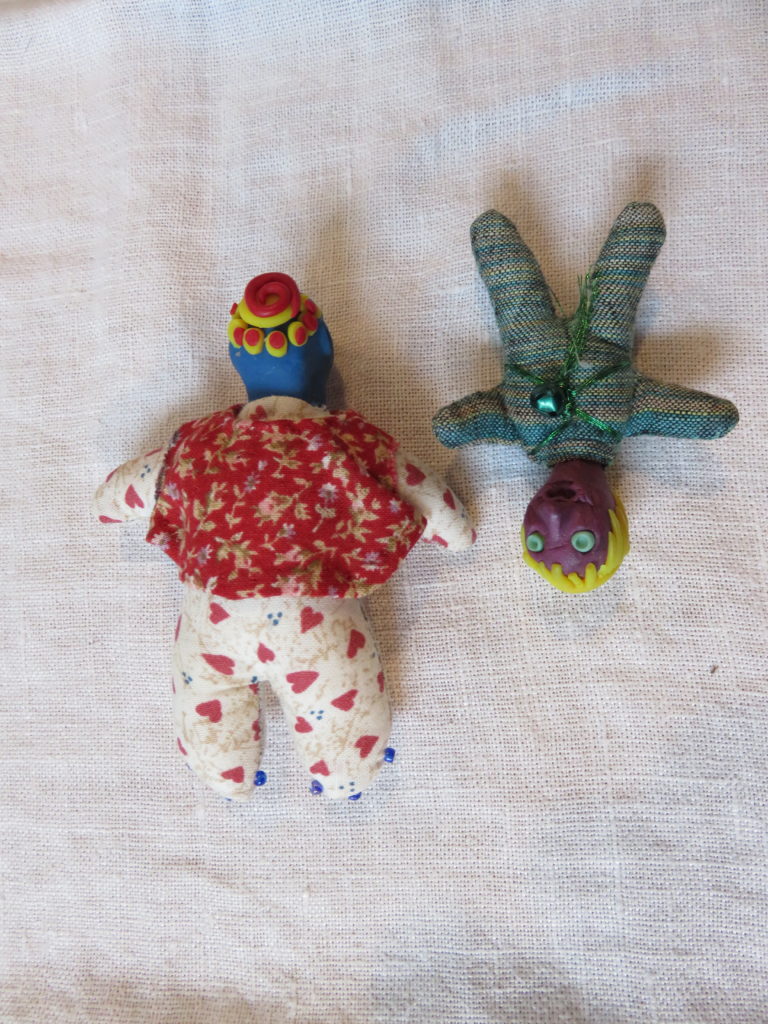
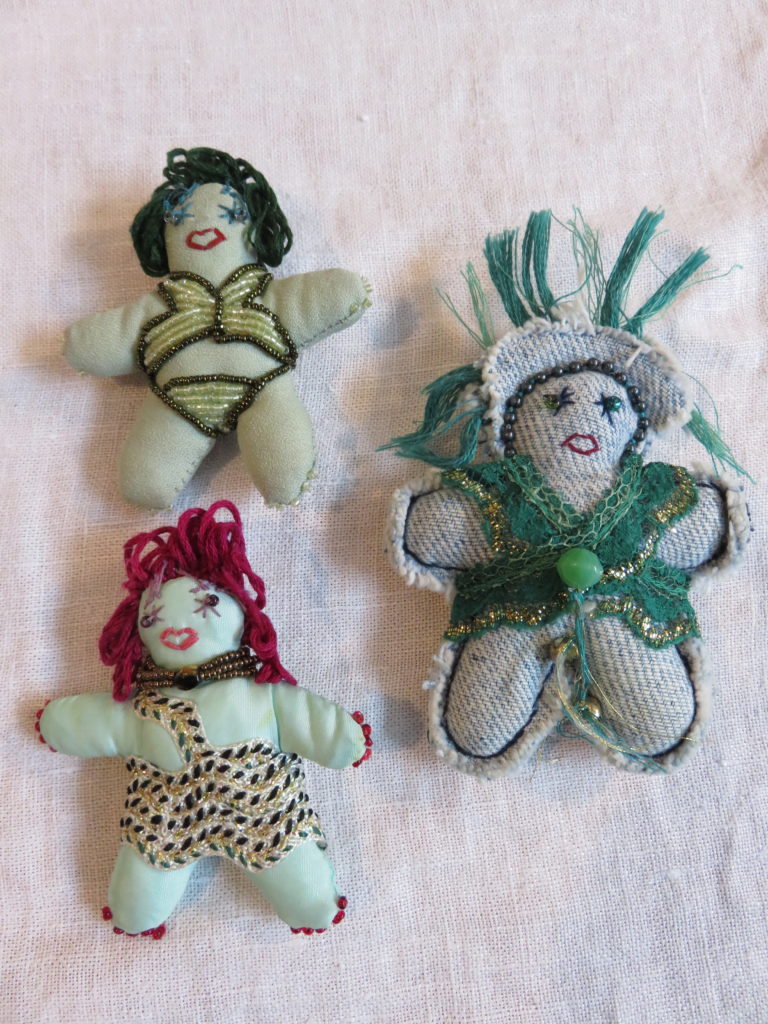
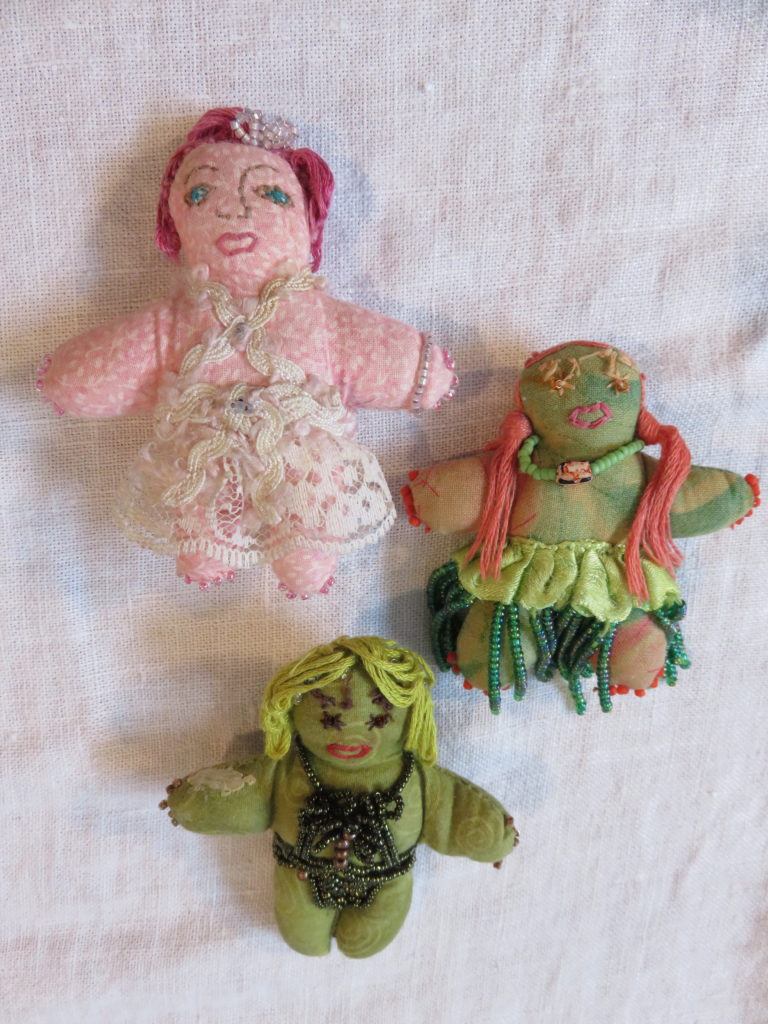
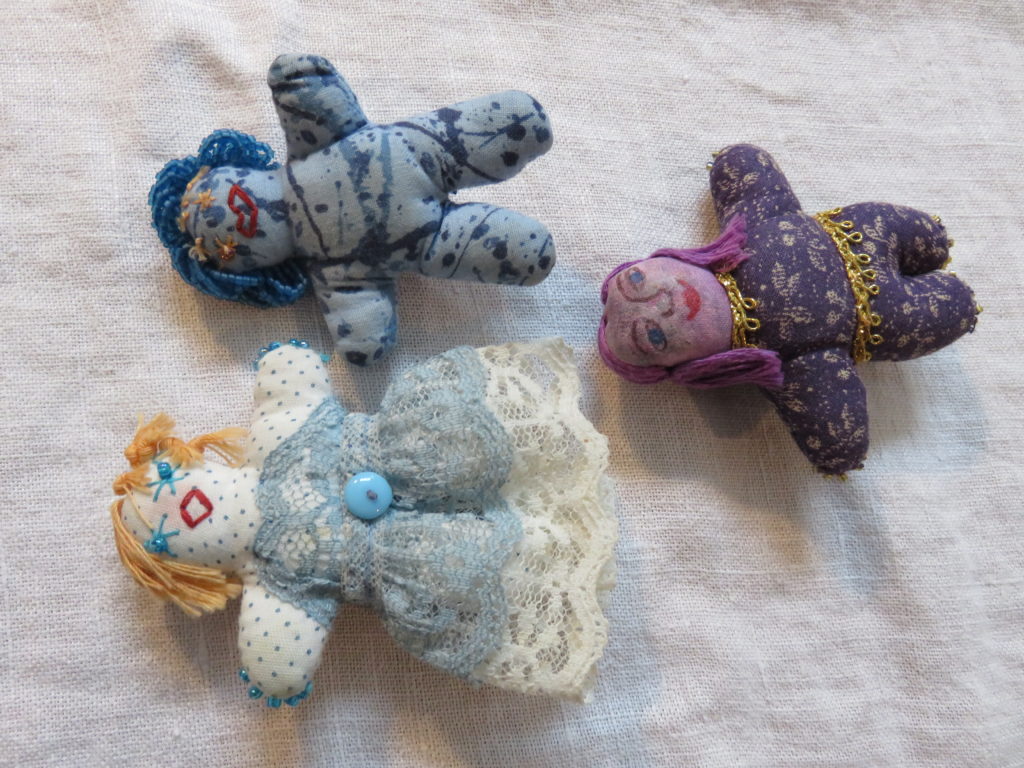
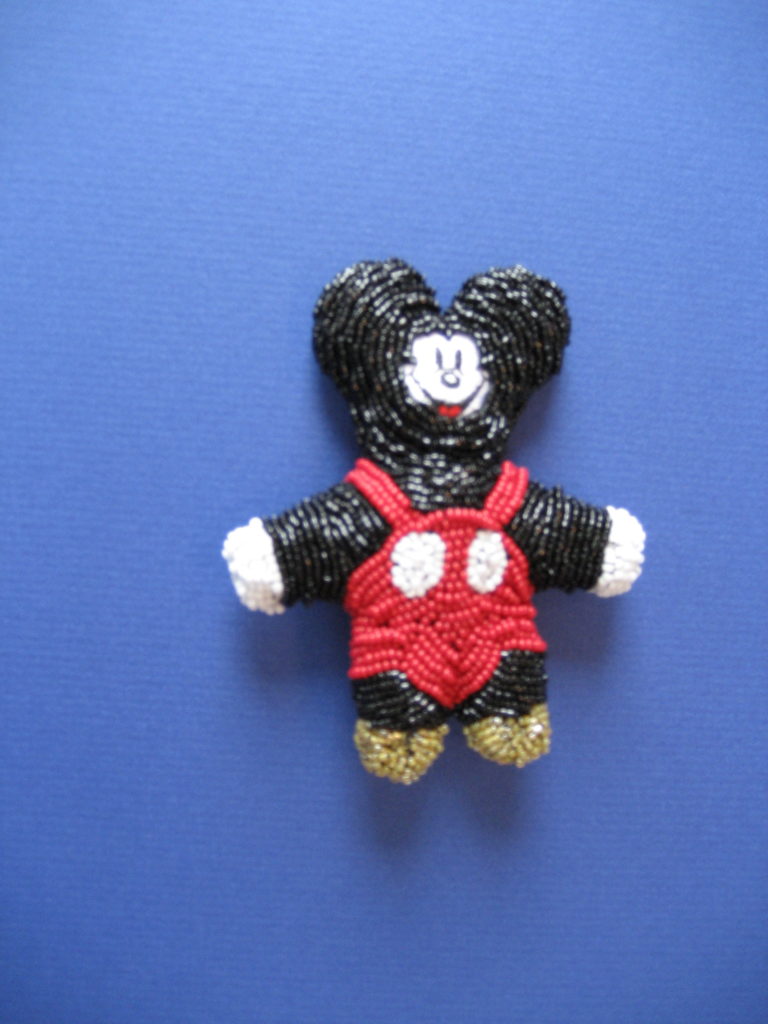
An AHA! Moment occurred when I realized I had boxes and bags of process and project samples for feltmaking (and other fibers processes). They were already of my own hand and design. I pulled them out and began to assemble them into larger sculptures (a technique I then used with students as well). I also challenged myself to create one-a day miniature artifacts to be assembled later into larger pieces.
“Pulls”
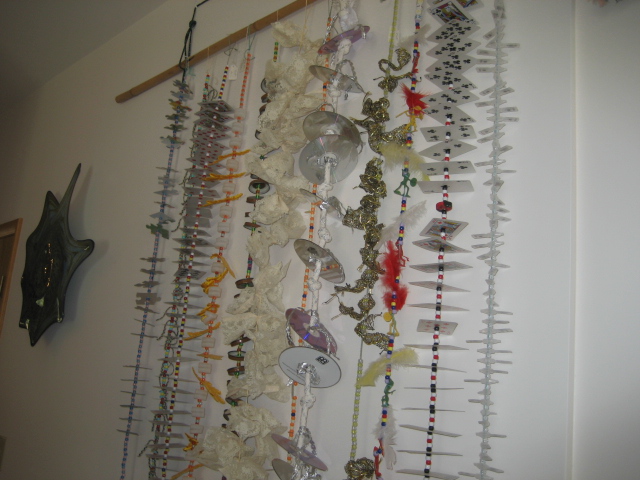
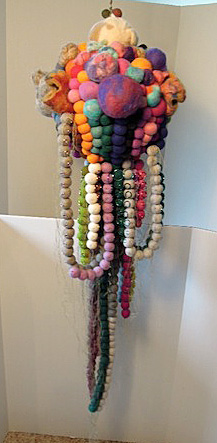
“It’s An Octopus!”
The challenge is the time. I dedicate time (usually weekend or evening) to get a project concept defined in my sketchbook and to organize materials. I look at my schedule to see where I might capture unscheduled time. And I always have a bag or a box loaded and ready when time suddenly and unexpectedly becomes available. I have rules:
- Never let my own art work interfere with planning for my classes and experimenting with materials and techniques before teaching them. Planning is important.
- Never work on my own art during teaching time.
- Request someone else drive whenever possible so I can work on a project during the trip.
- Always have a journal or paper to write down ideas, things to remember, and to record discoveries and things I learned.
- Collect materials and experiences on every walk, vacation, and opportunity.
- Never throw away project failures or demonstration projects. They may serve another purpose later. At the very least, failures help me remember how NOT to do it (because otherwise I will usually do it the unsuccessful way over and over again).
- Teaching others is a prime way to learn and improve my own skills.
- There is always something to be learned, even in the most repetitive experience.
- ALWAYS be ready to work on a project…. i.e. ball gown components created while sitting at Little League games.
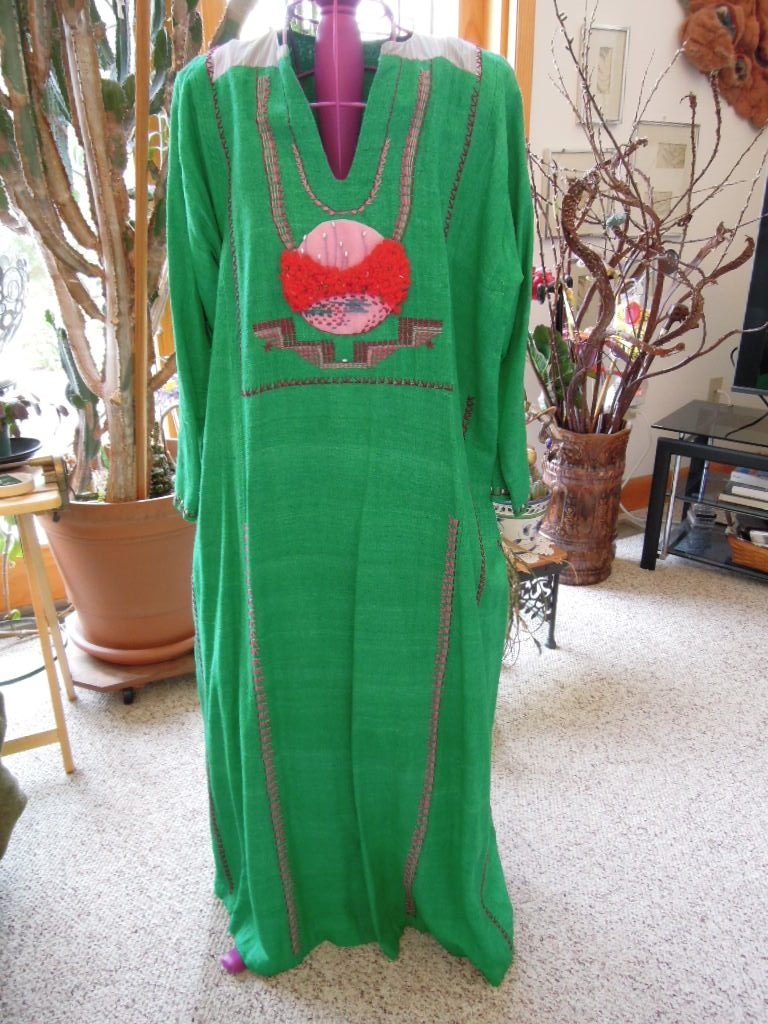
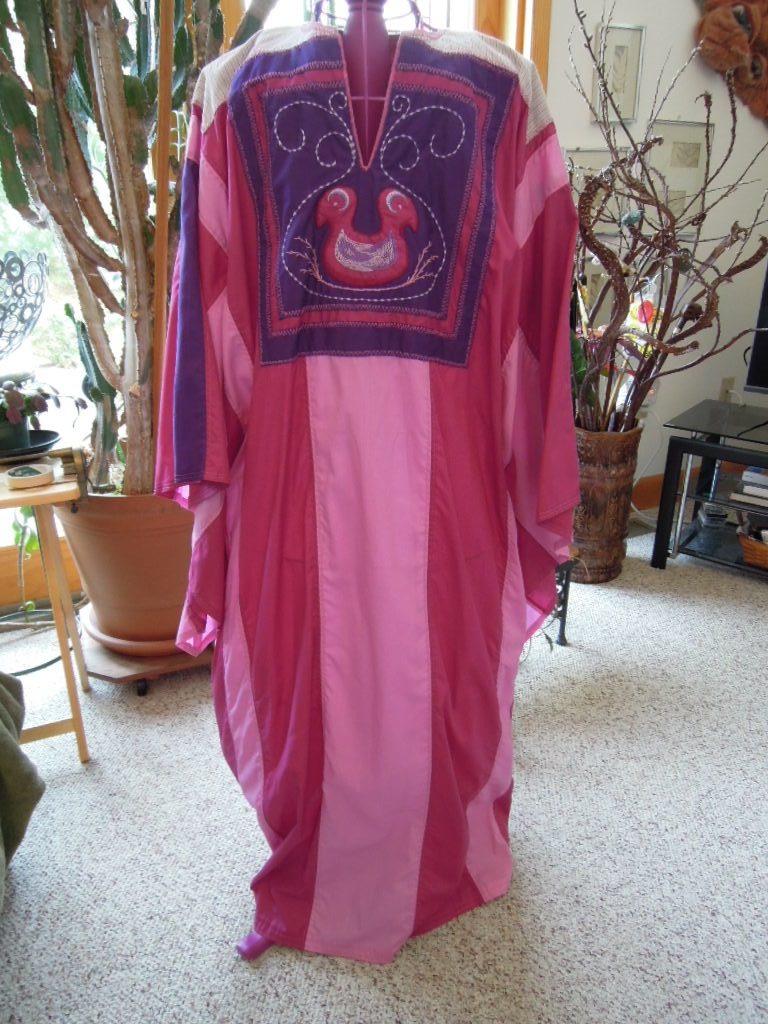
If nothing else inspires, I can always redesign/embellish wearables from my closet.!

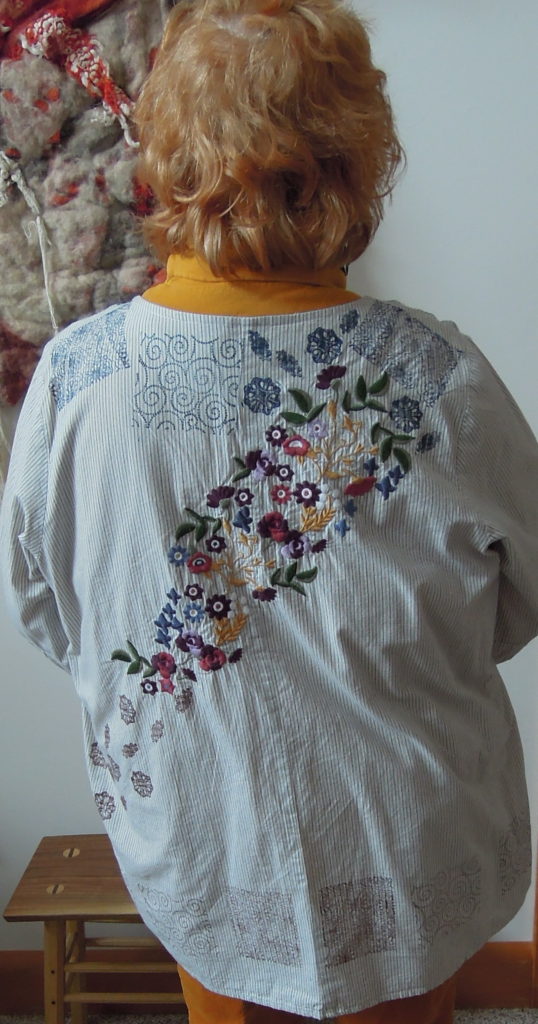
C’est Finis!
Conference Key Note Sneak Peek
Have you signed up for the PAEA conference in Harrisburg yet?? It’s coming up!! 3 weeks away…October 5-7! I personally can’t wait!
Do you know about one of the Key Note speakers, Wynne Kinder?? Read below to find out more!!
WYNNE KINDER, M. Ed. Wynne’s teaching career spans 28 years in private and public schools, most recently including 13 years bringing mindfulness into regular, special (autistic & emotional support) and alternative education (including incarceration) settings. As owner of Kinder Associates LLC and trainer for Wellness Works in Schools™ (preK-12 classrooms & teacher training), she creates curriculum, programming, online trainings and teaching tools that address: mindful awareness, diverse learning needs, trauma in the classroom, healthy connection, social emotional skills, engagement & participation, and behavior guidance. Her work is informed by training with: the Mindfulness-based Mind Fitness Institute, the Trauma Center – Justice Resource Institute and UMass Mindfulness-based Stress Reduction. Wynne is the author and content creator of: Peace Work – mindful lessons for the early years,Mindful Moods – a mindful, SEL curriculum for grades 3-5, Mindful Choices – a mindful, SEL curriculum for grades 6-8, a chapter on special education in Teaching Mindfulness Skills to Kids and Teens (2015), GoNoodle.com’s digital brain breaks (mindful SEL themes in FLOW, Think About It, Maximo, BLAZER Fresh) & Audio practices for MindfullyADD.com. She has practiced mindfulness for more than 15 years and received training in Mindful Yoga, Mindfulness-Based Stress Reduction, Trauma Sensitive Approaches through the Justice Resource Institute (MA), Boys Town – Teaching Social Skills to Youth; CASEL, Mindfulness-based Mind Fitness Institute (VA), Yoga Ed teacher training, and Social Action Teacher Training – Lineage Project (NYC). Wynne holds a PA Teaching Certificate (K-6) and earned a bachelor’s degree in elementary education from Alma College (MI). www.wynnekinder.com
Spring Symposium at Moore College of Art and Design with School District of Philadelphia Art Teachers!
Guest post by:
NAEA Special Needs in Art Education President-Elect
On May 18th, 2018 Moore College of Art & Design’s MA in Art Education with an Emphasis in Special Populations program hosted its annual Art Education Symposium titled “Creating Multiple Modalities of Language in and Through the Arts”
We were honored to have this event sponsored by A.C. Moore!
The symposium featured regional Art and English Language Learner instructors Angela Renish, Lori Logan and Erica Mandell who shared their personal stories, knowledge, and skills on developing inclusive practices for English Language Learners in and through the arts. The afternoon included lightning round, hands-on workshops that offered attendees easy takeaways to incorporate into their teaching methods.
Session A with Angela Renish: Visual Tools and Strategies for Making Art Lessons Accessible for English Language Learners.
Session B with Lori Logan: Visual Structures for Engaging English Language Learners in All Educational Settings.
Session C with Erica Mandell: Art Lessons with an Emphasis on Social Justice for English Language Learners.
Save the date for our Fall 2018 Symposium
Saturday, November 3rd ““Understanding Our Humanity Through the Arts”
Learn new skills and strategies that address our diversity, identity, and different abilities through the arts. Featuring keynote speaker Justin Brown and session leaders Sika Wheeler, Christina Lukac and Amanda Thoma.
Photos by Riley Evan Lloyd
PAEA trip to Cuba!
Hola, Art Teachers!
This Summer, members of PAEA embarked on a trip from Pennsylvania to Havana to experience Cuban culture, learn about art and education there, and share ideas and inspiration with our fellow teachers.
In the midst of this Socialist island, we found ourselves in a sort of time warp, surrounded by latino culture, 50’s Americana, 70’s and 80’s Soviet influences. With our guide, we visited cities, small towns, and a biosphere, swam in rivers and the gulf, and met local Cuban artists in many mediums.
Instead of a complete reiteration of our itinerary, I thought I’d share a few inspirational highlights, with a special focus on those that I felt might lead to lesson plans:
FUSTERLANDIA (Jaimanitas, outside Havana)
Mosiac artist José Fuster has created a whole magical neighborhood, constantly expanding for the past 20 years. It was cool to explore the grounds and walk through his workshop, finding repeating themes and symbols in his work. His simple images and complicated forms reminded me of Isaiah Zagar’s Magic Gardens in Philly! I think I’m going to revamp an old Zagar lesson, showing some images of Fusterlandia to my students. What is the same, and what is different in these two artists’ work?
CAMERA OBSCURA (Plaza Vieja, Havana)
On the top floor of a vila in Havana (115 ft up!) a “Cámara Obscura” (invented by da Vinci) uses mirrors and a lens to project a live 360 degree view of Havana onto a platform in a pitch black room. I was in awe – as a photo student, I’ve been introduced to the concept of camera obscura, and even seen some primitive examples of it. This one though, blew me away. The operator used manipulated it and focused it with such precision that we could see individual figures on rooftops having breakfast and going about their days, far from where we stood. Two PAEA members shared ways to create camera obscura lessons with students in your studios or art rooms!
ANTWERP HANDS (Children’s Museum in Havana)
Across the plaza, we found a children’s art gallery featuring a traveling exhibit from Antwerp Hands. Loads of illustrated hands featuring the theme of friendship were on display, along with the ideas of different culture’s phrases, stories, and lore involving hands. I’ve got a feeling I’ve got a hand project in my future!
KORIMAKAO CULTURAL PROJECT (Zapata wetlands)
This rather out of the way spot is home to Korimakao Community Arts Group – which brings art, theatre, music and dance to small towns and the rural communities of Cuba. When we visited, we were treated to an enthusiastic live music performance, saw dancers perform in their studio, and got to see the visual art gallery featuring member’s work. The work on display gave me some ideas about presenting work in shows – particularly these cool spin art paintings which were displayed on light boxes! Definitely gave this work an added dimension.
SANTANDER POTTERY (near Trinidad)
We got to visit the Santander family pottery studio. All of us art teachers have thrown on a wheel at some point, and I gotta say, we were blown away with the deftness and skill we saw from these master potters. I’ve never seen something I know to be difficult look SO easy. It was awesome to get a live demo!
Among all the pots and vases (which were available for purchase, and yes, broke in my luggage on the way home), were these very cool delicate windchimes. I bought two, (one for home and one for my art studio), where I hope to use it as an inspiration so we can do some collaborative work with some air dry clay. Maybe each class will make one together?

RECYCLED OBJECTS
One thing we noticed again and again through our travels on the island was the use of recycled materials. Like I do, you may associate Cuba with a sort of vintage aesthetic, and that’s no joke. With US embargoes going back 50+ years, access to general supplies can be sporadic, and acquiring “frivolous” materials (like art supplies) is nearly impossible. We saw so many beer cans, bottles, second hand fabrics, even palms – repurposed into visual art. I bought a couple small items that fit the bill to bring back and show my students when it comes time to do a recycling project! I know they’ll be impressed with the craftsmanship and ingenuity.
EMBROIDERY (mainly in Trinidad)
I can’t resist some beautiful embroidery. We saw so much cool textile/embellishment work (particularly in Trinidad) that made me decide I *must* get some needles and thread (or…floss?) into my kids hands next year. Gotta work on the logistics for that one!
TILE (Havana and Trinidad)
Sooo many crazy tiles. In the cities with older architecture, the beautiful ceramic repeating patterns were everywhere, and I couldn’t resist them. Bright colors, geometric and organic shapes, crazy combinations. Working out how I might implement this in a lesson. And into my kitchen.
What an awesome opportunity to bring new perspectives to our students. Can’t wait to see where else PAEA might go next! Keep your eye on the blog, IG, and turn out for conferences to learn more.
Video of our trip here!
Organization in the Art Room
The following query was posted to our PAEA Facebook Page. Members chimed in, and their responses are below for your benefit and organizational enjoyment! I’m getting goose pimples already thinking about the wonderful ways to organize!!!!
“Please share some of your unique and successful classroom organizational devices/structures. How do you store 2-D work? How do you store 3-D work? What do you feel is necessary to always have on the table? What are your art room life hacks? Etc…”
Marita Fitzpatrick of Bodine High School in Philadelphia suggests: “For small 3d (our recent stuffed toys): I have a copy paper box for each class. The students put their work in manila envelopes, write their names on them and I have one person from each table collect the envelopes and return them to the box. For 2d, each table puts their work in folders marked w the table color (tables are color-coded) and that goes in the copy paper box. This box is marked, period 1, period 2, etc. I have a closet of shelves for ceramics and each kid gets a shoe box to store their stuff in. It keeps the others from touching the work and breaking it. Students wrap their work in dry cleaning plastic to keep it moist. I regularly have kids empty the drying rack, sort the work and put it in the copy paper boxes. I keep nothing on the tables, because the stuff disappears and they put trash in the containers. I store markers and colored pencils in plastic pencil boxes on open shelves in the room and number them. I never look at the numbers or count them, but the kids think I do, so nothing disappears. On those shelves, I also have scissors and other frequently used supplies that students have open access to.”
Alison Elizabeth of Lancaster, PA shares her planning strategy: “Each class I teach is a different colored sticky note. This calendar is glued into the front of my sketchbook (which I use for all of my demos, meeting notes, and conference notes). It’s all with me and ready to go at all times.”
Linda Keels suggests making the investment in folding tables from the local hardware store (she uses 3) for about $30-40 a piece—there is room to hold up to 6 classes worth of work (she teaches 12) which forces her to keep it moving and the kids to stay on track for 3-D things.
Eleanor A-Evans For stores 3D work, such as clay sculptures and paper mache on ‘mobile pan racks’ (like the one in the photo- thanking Google image search). Depending on your supplies resources, the cost on the average is under $90, and can be the solution for saving space and stowing away the masterpieces!
Julie Schedin share with us how her students creatively tackle this issue with a little design thinking! “My Crafts class yarn bombs a coat hanger. They own the airspace above their seat, and hang all work (basket weavings, etc) from the coat hanger in the drop ceiling. The room develops a type of “rainforest canopy” but a least we can keep 3d projects organized and handy.”
Judi Treffinger of Carlisle, and formerly the Carlisle Area School districts has an idea for yarn storage! “You know all those large gallon sized plastic food containers your cafeteria gets when they purchase food? I duct tape then together with the open sides up and use them to store and separate skeins of yarn. They can sit on a counter top, or stash neatly in a cupboard with open ends facing out- all colors are visible and yarn doesn’t get tangled!”
Moore College of Art and Design Alumni, Autumn Rae suggests art teachers to follow her Instagram: mrsdow_artroom where shes posts things about classroom display and specific grade levels k-5 . She posts lots of classroom things about organization what materials I use.
Autumn also shares:
“- Container store bins are the best!
– It needs to be organized and colorful for me to function. I cannot stand messes or piles.
– I keep messes at the middle table whenever possible.
– I use my drying rack when I can but I actually love rolling out a sheet of paper and either working on the floor with the kiddos or having them dry their work flat and organized on a sheet of paper. Work great for printmaking each student gets a row for all their prints.
– All my notes are on my Instagram that describe each photo and what it relates to classroom, display, or a grade level.”
Autumn teaches art to 881 students k-5 students. She describes, “We are an emotional support school with a high ESL population and also a title 1 school. I have put lots of my own money into my class but once the upfront cost is paid off then I have all these organizational systems in place for years to come. I need everything organized like I said but also kid friendly. I have created two closets for classroom teachers and stock it at the beginning of the year so they don’t ask me for supplies I need for my own classes.”
Woah Autumn! Thanks for all of that!!! Loooooove the colors!!! And there is no denying where those pencils came from!!
Daisy Konowal uses a system of table color folders. 2 sets- one for work in progress and one completed work. Also, Daisy uses sheets/fabric/blankets to cover her shelves to limit access to shelves.
Sunnylee Mowery of Philadelphia’s Greenfield Public School strives to make my classroom organization methods so easy a kid can do it! Each table is color coded and this helpful chart rotates at the start of each week so everyone knows who is in charge of what. The artists are expected to pass out work and supplies, monitor volume, tidy table bins and floors, and even call each other to line at the end of class.
Sunnylee has clearly labeled bins with teacher name are organized by grade level. All supplies that accompany the project are placed above in their grade section.
Sunny poses the question, “How do students monitor sound, you ask? The volume giro migrates to the table in charge of volume each week. If the room gets too noisy, the students “ring” the giro to signal to the class to quiet down. If we get 3 giro rings, we lose the privilege to talk.”Click Here for a link to the video of the magical giro sounds that have the power to quiet students!
Kim Horan Colasante, art teacher in the School District of Philadelphia shares, “My routine is very much the same as Sunny’s. Each table has a color, table folders or student folders are matched to the table they sit at. I have a job chart, students give out folders, supplies, paint patrol, and floor sweepers. Jobs rotate weekly according to table colors. Supplies are located in front of the room and Barney’s Cleanup song plays at the end of every class 10 minutes to go. The students know to stop, put their work away and do their jobs. The ones that are done sing to barney. (I teach middle school) they dab to it also. It only plays for a minute so work must be away by the time song is done. then folders are collected and floors swept etc. 3D work is done a bit differently due to lack of space in classroom. When Barney plays each table brings me their 3d work and I place it in a special section so that they may retrieve it the following day. Clay is kept in large Rubbermaid containers until in it ready for drying.”
What do you do in your classroom?????
Sneak Peek: Clayprinting at PAEA 2016
Some of the conference presentations I find most valuable as a teacher feature hands-on demonstrations. With that in mind, I offer you something else to add to your list of “Things to Check Out at the Conference” this year! Potter turned printmaker, Mitch Lyons will be doing a demo on making clay monoprints – bright and early Friday morning! I love printmaking with students, and I feel like they’d be very into these techniques (and the results):
Check out Mitch’s work at his website, and read the description below:
Mitch Lyons, innovator of the clayprinting process and author of The Art of Printing with Clay, will be demonstrating at this year’s PAEA Conference on Friday, October 7th, at 9:00 AM.
Since 1968 Mitch has been pioneering his image making from a slab of leather-hard stoneware clay. Mitch will demonstrate how he applies colored slips, one color over another, and then builds a design using textures, slip trailing, pastels, and stencils. Once ready to print, a moistened piece of paper/canvas is placed over the slab. Pressure is applied using a rolling pin to transfer the clay slips onto the substrate to create a one-of-a-kind clay monoprint. Using very simple techniques and tools, he is able to achieve very sophisticated results. You’ll be inspired to take this simple, non-toxic printing process back to your own classroom to teach your students!
You can view examples of Mitch’s clay monoprints by visiting his website mitchlyons.com. Several videos are also included on his site that show the process in action. Visit him later at his booth in the vendor area where he will have his book, DVDs, calendars and more for sale.
Sneak Peek: Rande Blank’s Presentations
Rande Blank has been the Director of the MAT in Visual Arts Education program since 2012 and a faculty member with UARTS – Art + Design Education department since 2003, teaching graduate courses, and mentoring students in their practicum experiences. Most recently she has been selected to be on the Advisory Council for the Design-Ed organization and the Director of the Higher Education Division for the Pennsylvania Art Education Association. (Text borrowed from http://www.uarts.edu/users/rblank )
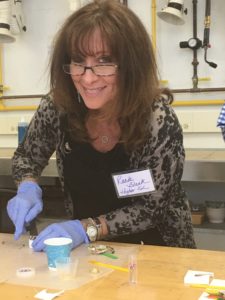 Rande will be delivering not one, but two presentations!
Rande will be delivering not one, but two presentations!
Support Your NAEA Student Chapter Through Fundraising Events: University Student Panel Discussion
Friday at 2:00 – 2:50 PM
University faculty and students discuss advocating for professional association participation, fundraising activities, conference proposal writing, and art education studio workshop opportunities. Experience pride and success with your university chapter.
Design Thinking as a Problem Solving Process: 5 hands-on participatory activities
Sunday at 9:00 – 10:50 AM.
Teach students to become independent, innovative and thoughtful decision-makers. Apply the design thinking cycle where problems are identified, solutions proposed, produced and evaluated. Participate in design activities to explore process.

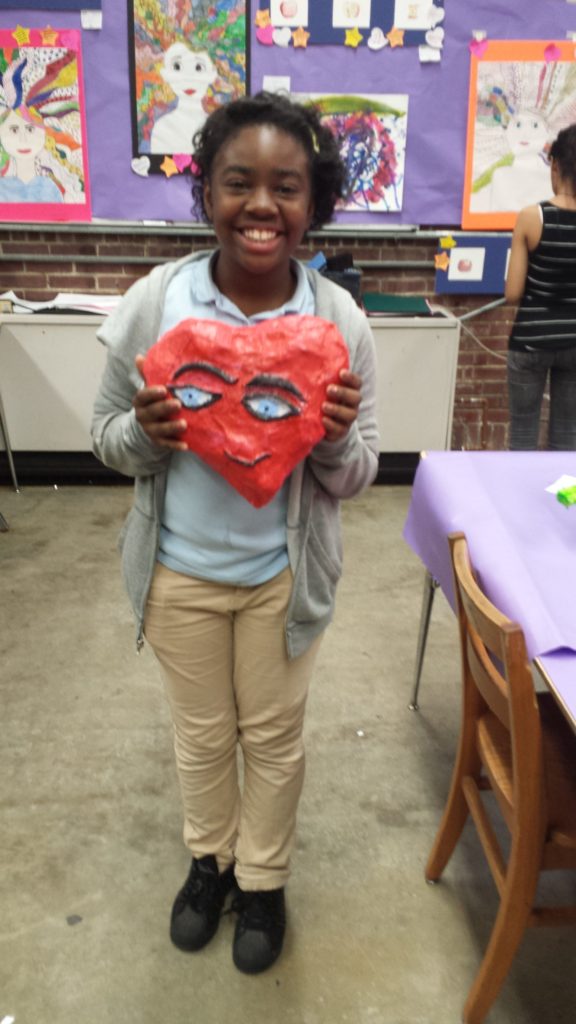
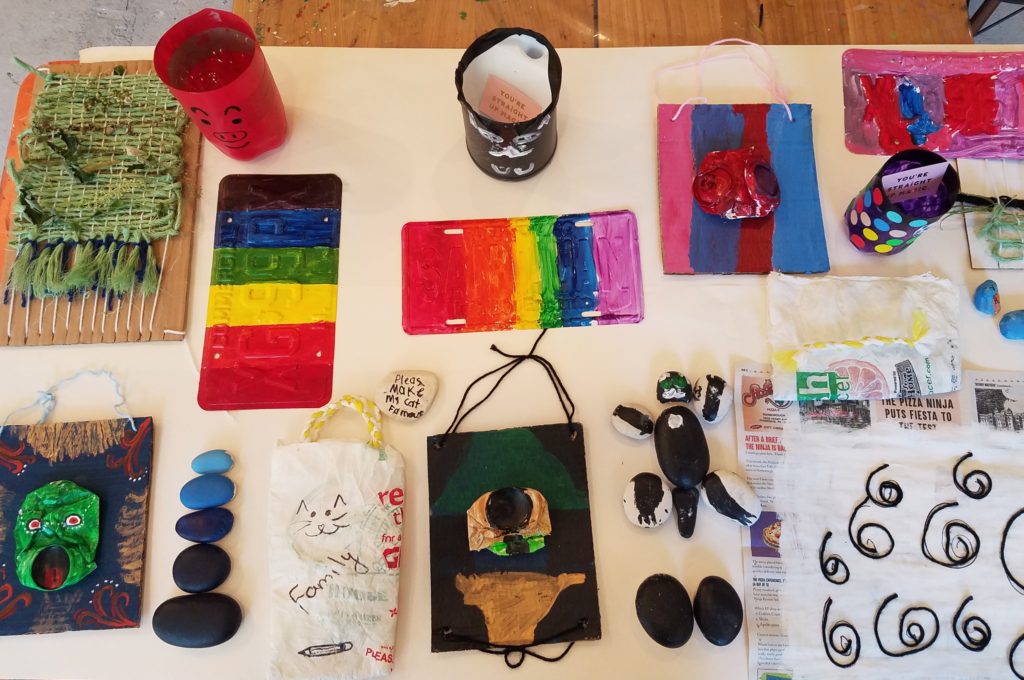
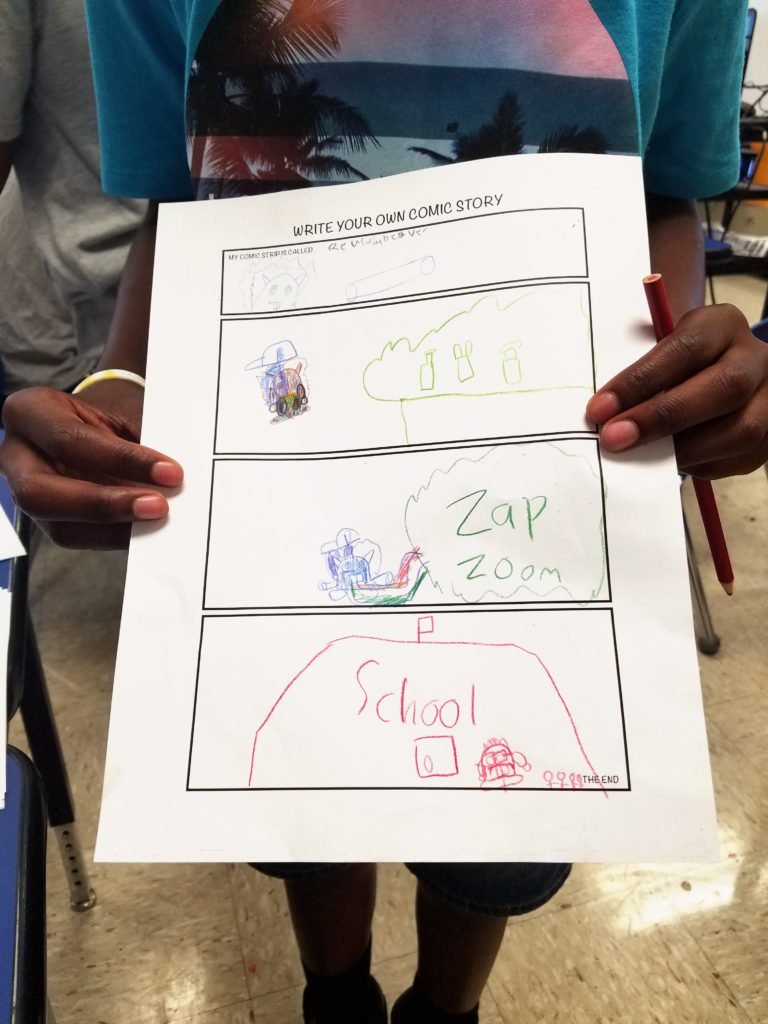

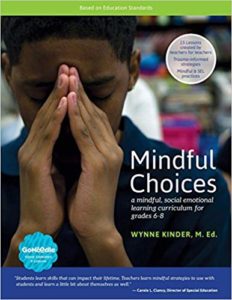
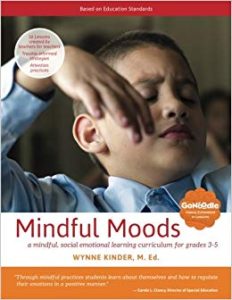
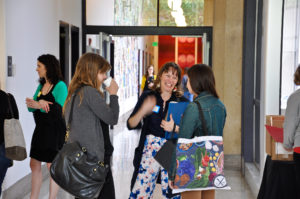
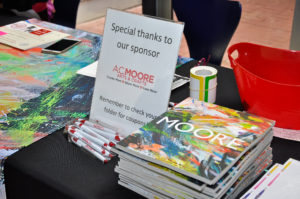
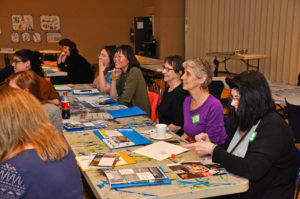
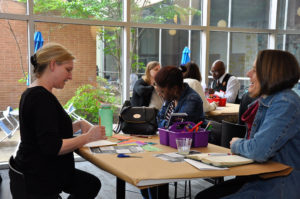
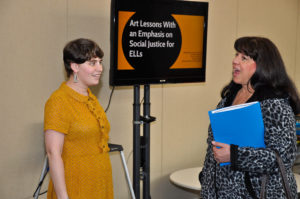
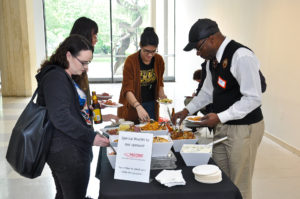
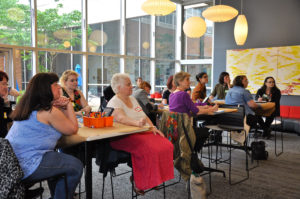
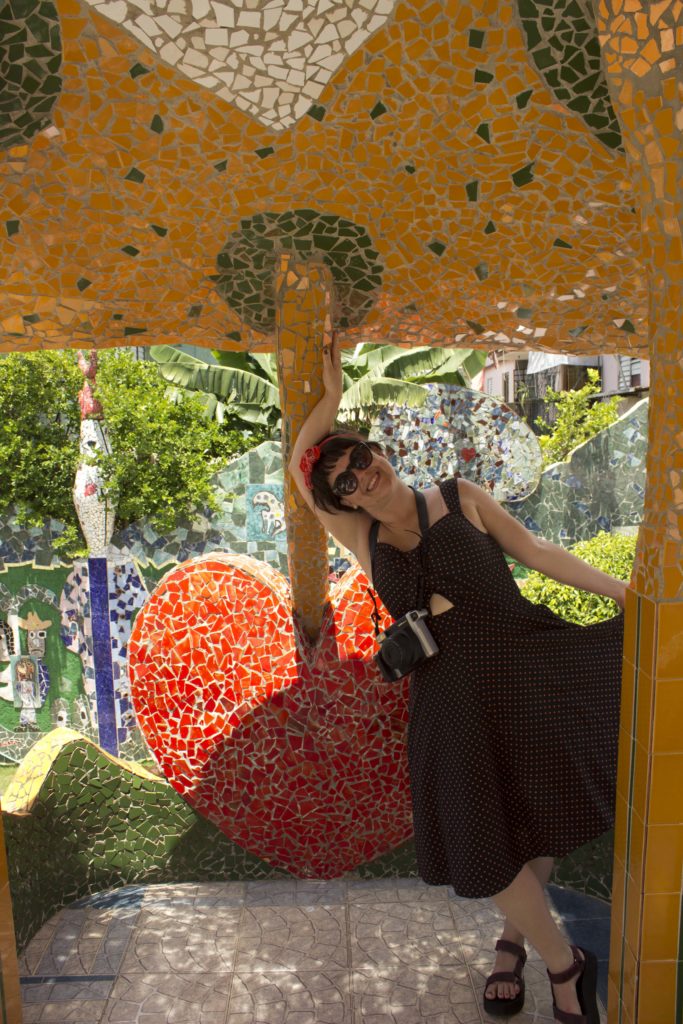

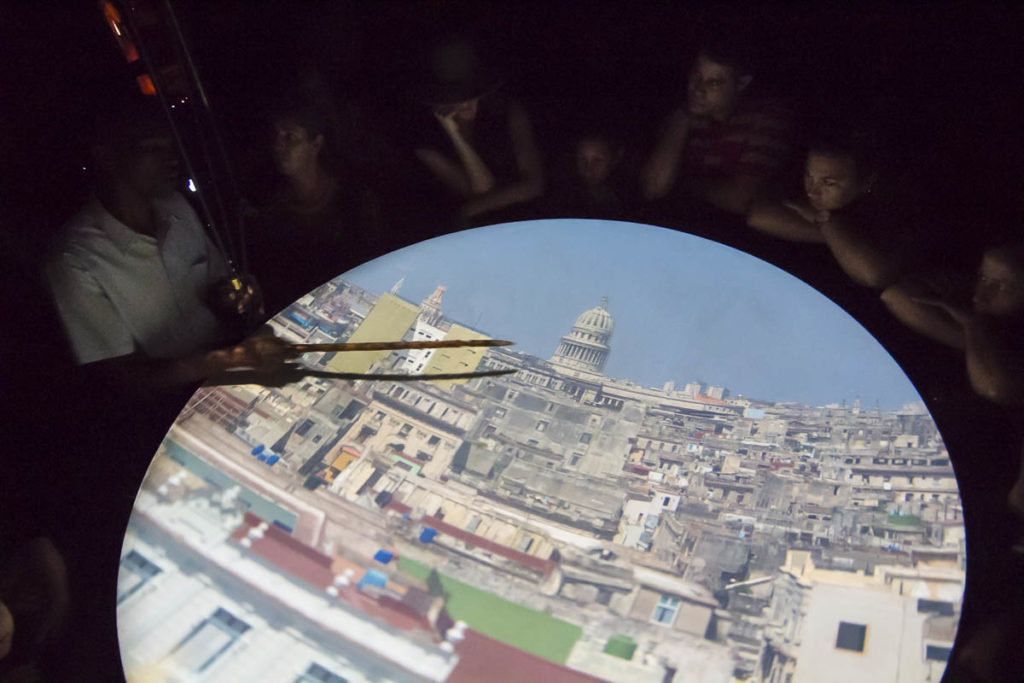
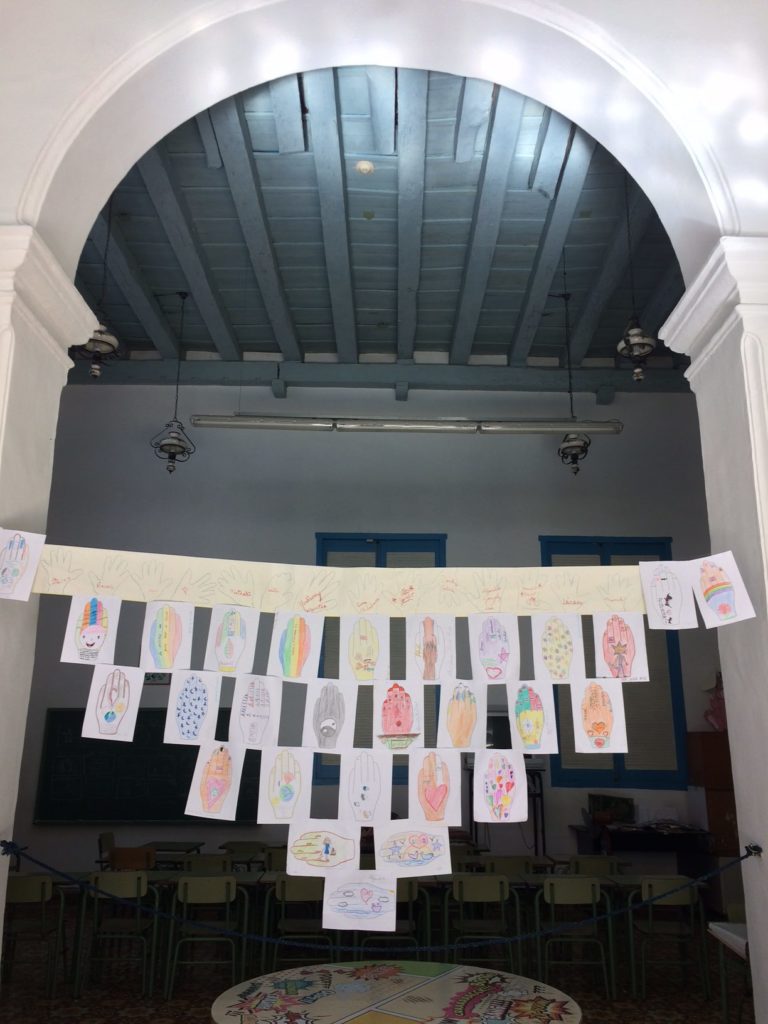
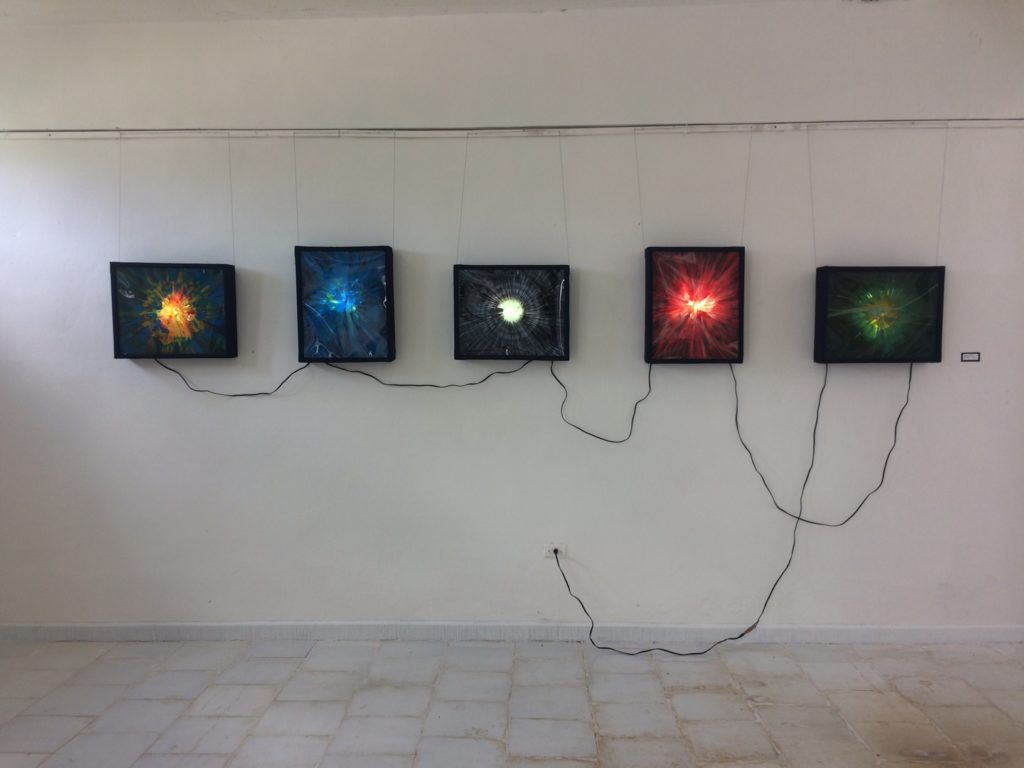


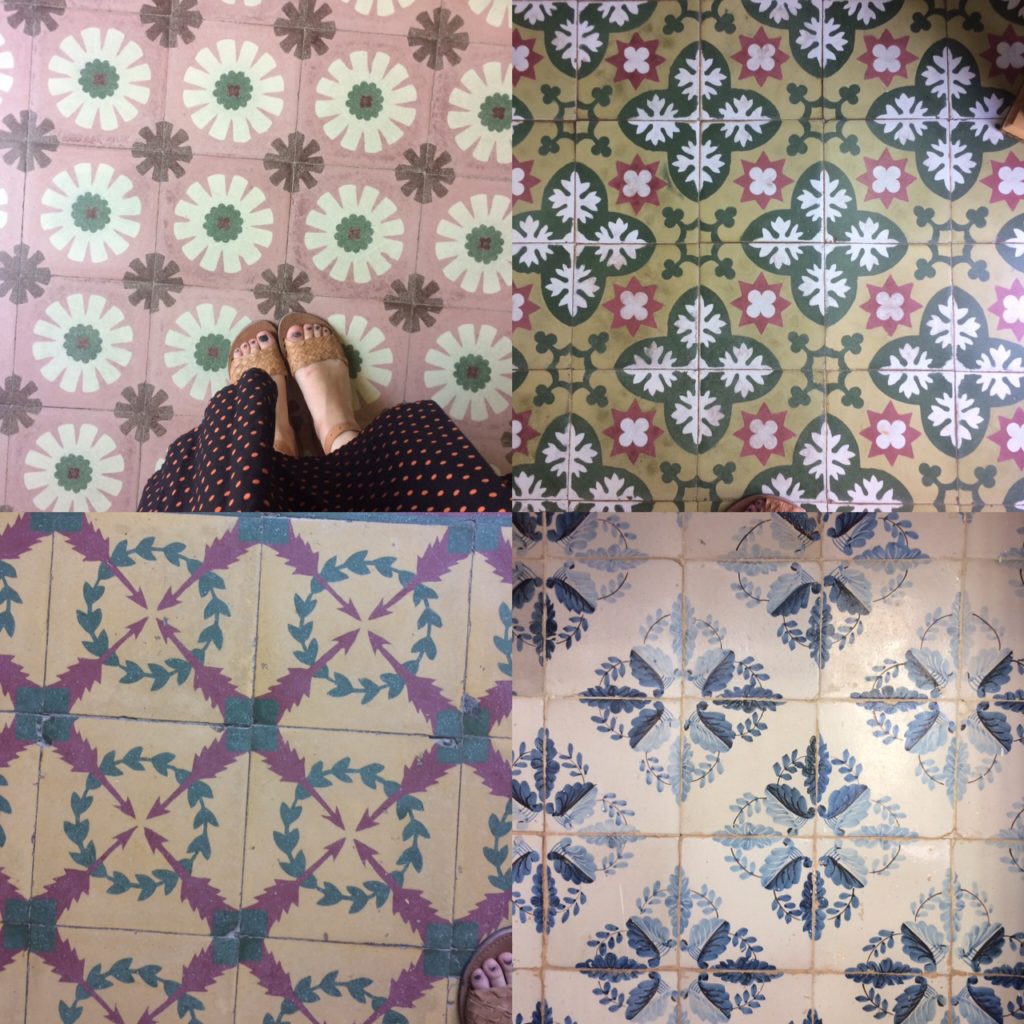
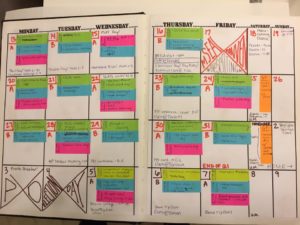
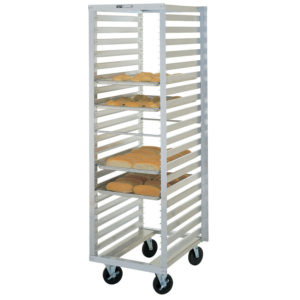
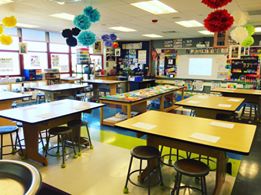

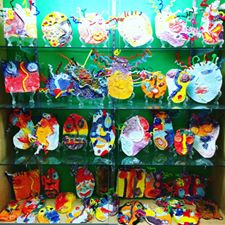
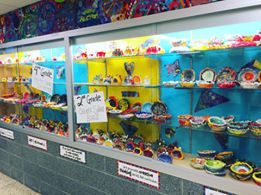
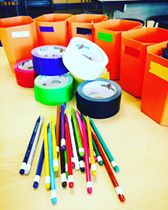
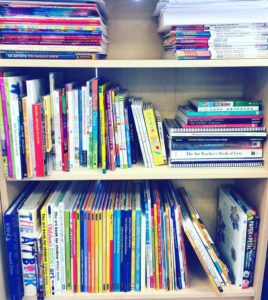

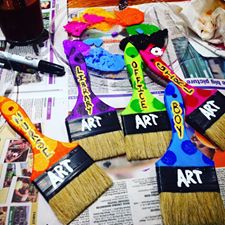
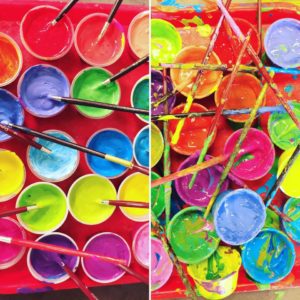
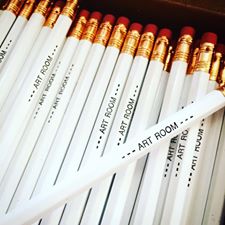
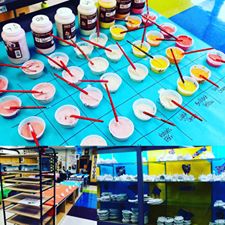
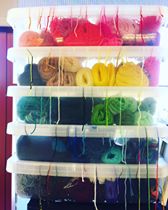
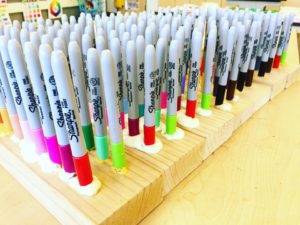
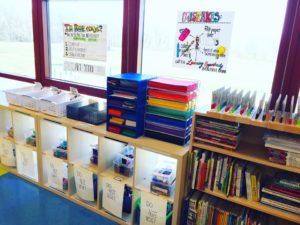
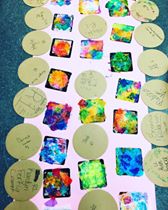

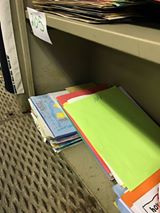
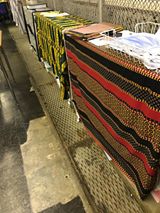
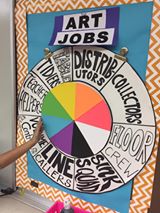
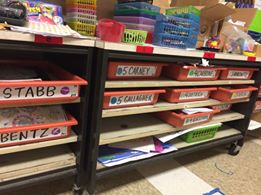
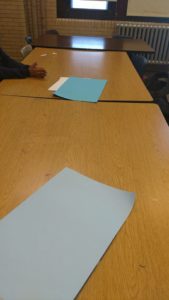
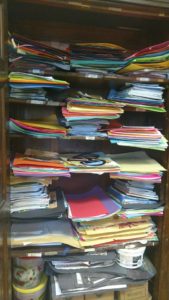
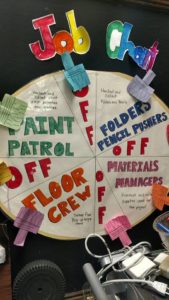
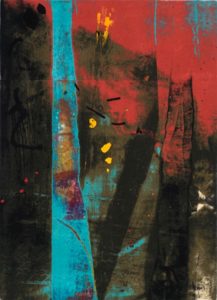

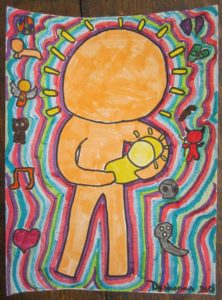
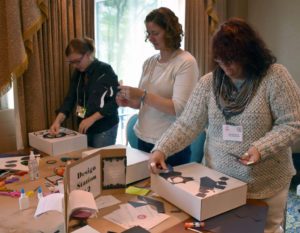
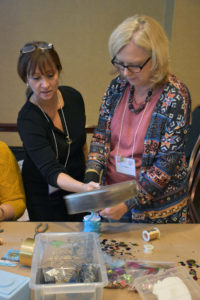
 D5 Creation
D5 Creation